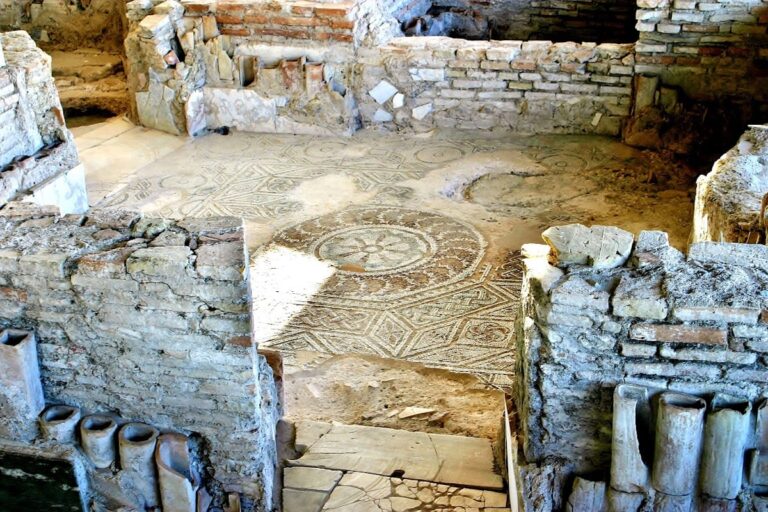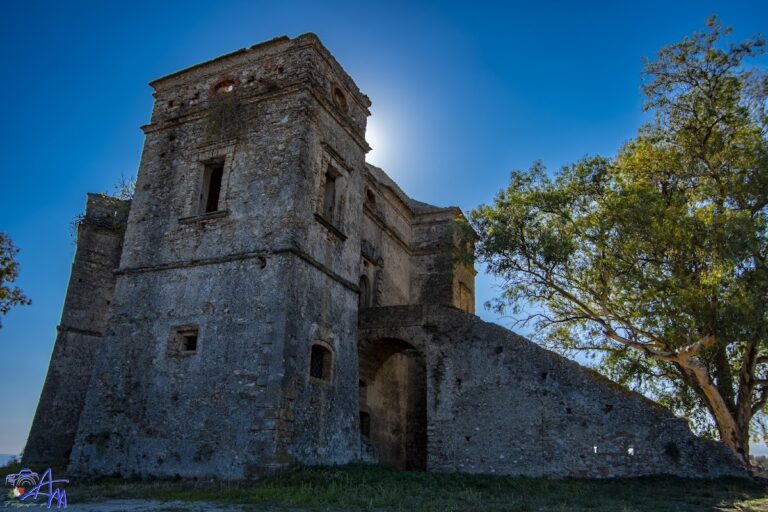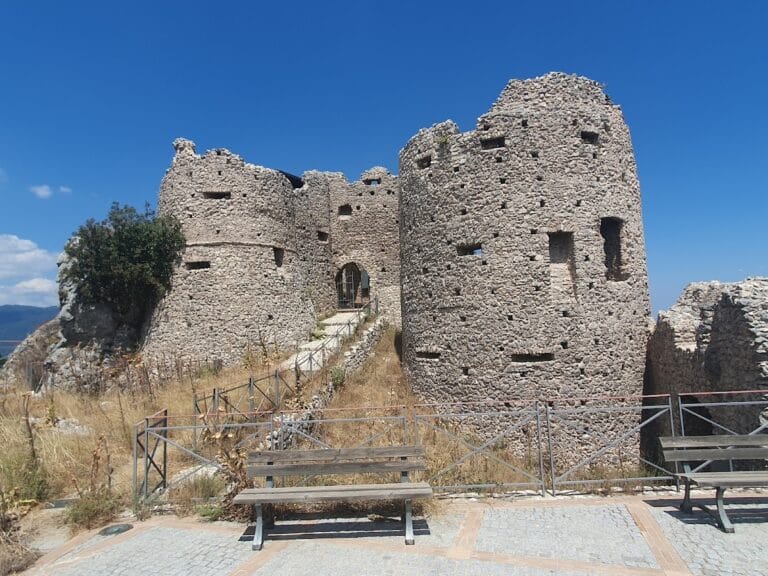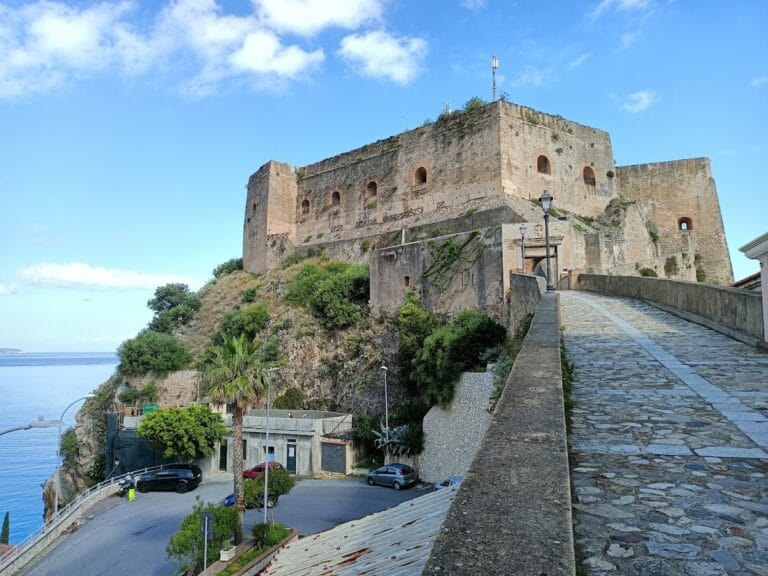Locri Epizefiri Archaeological Park: A Greek and Roman Heritage Site in Calabria, Italy
Table of Contents
Visitor Information
Google Rating: 4.3
Popularity: Low
Google Maps: View on Google Maps
Official Website: musei.calabria.beniculturali.it
Country: Italy
Civilization: Byzantine, Greek, Roman
Remains: Burial, City, Civic, Domestic, Economic, Entertainment, Infrastructure, Military, Religious, Sanitation
Context
The Archaeological Park of Locri Epizefiri is located within the modern municipality of Locri in Calabria, southern Italy, positioned along the Ionian Sea coast. The site occupies a coastal plain framed by low hills, a landscape that provided both strategic advantages and access to fertile agricultural land. Its proximity to the sea facilitated maritime connections across the central Mediterranean, while the surrounding hinterland offered resources for cultivation and settlement expansion. The topography influenced the city’s urban planning and defensive architecture, integrating natural features with constructed fortifications.
Founded in the late 7th century BCE by Greek colonists, Locri Epizefiri developed as a prominent polis within Magna Graecia, maintaining continuous occupation through the Classical, Hellenistic, and Roman periods. Archaeological stratigraphy and material culture attest to its sustained urban presence until late antiquity, when regional socio-political transformations led to its decline and eventual desertion. Excavations initiated in the early 20th century have uncovered extensive remains of public, religious, and domestic structures, providing a comprehensive record of the city’s long-term development and cultural phases.
Today, the park preserves a well-documented archaeological landscape that reflects Locri’s historical significance as a Greek colonial foundation and later Roman municipium. The site’s conservation is overseen by Italian heritage authorities, ensuring the protection and study of its architectural and sculptural heritage within the broader context of southern Italy’s ancient urban networks.
History
Locri Epizefiri’s historical trajectory begins in the late 7th century BCE with its establishment by Greek settlers originating primarily from Locris in mainland Greece. The city emerged as a key polis within Magna Graecia, distinguished by its political institutions, religious cults, and commercial activities. Over subsequent centuries, Locri navigated the complex dynamics of southern Italy, maintaining its identity through the Archaic and Classical periods before transitioning under Roman control. Its history encapsulates the broader processes of colonization, cultural interaction, and imperial integration characteristic of the region.
Situated on the Ionian coast, Locri’s strategic location linked it to maritime trade routes and regional power struggles. Although it does not feature prominently in accounts of major military confrontations, the city’s fortunes were shaped by shifting alliances, conflicts with neighboring communities, and the expansion of Roman authority. Archaeological and epigraphic evidence document its evolution from a Greek polis to a Roman municipium, followed by decline in late antiquity amid wider socio-political upheavals.
Archaic and Classical Periods (Late 7th century BCE – 4th century BCE)
Locri Epizefiri was founded in the early 7th century BCE by Greek colonists from the Opuntian Locrians, supplemented by groups including Ozolians, Spartans, and fugitive slaves, settling on a pre-existing indigenous Oenotrian and Sicel site near the Zephyrian promontory (modern Cape Bruzzano). According to Aristotle, the founders were servants who fled with their masters’ wives during a conflict, initially settling near the promontory before relocating approximately 12 miles north to the coastal plain at Gerace Marina, the site of the later city. The city’s political structure was oligarchic, governed by the “Hundred Houses,” a council of elite families.
Locri’s early prominence is linked to the lawgiver Zaleucus (circa 650 BCE), credited with one of the earliest known written legal codes in Europe, notable for its severity and role in regulating social order. The city flourished as a commercial center within Magna Graecia, establishing colonies such as Hipponium (later Vibo Valentia), Medma, Mataurus, and Torre Galli. Archaeological evidence includes cemeteries with indigenous funerary assemblages dating to the 9th century BCE and the sanctuary of Persephone (Persephoneion), a major religious site located just outside the city walls, referenced by Livy and known for its votive terracotta tablets (pinakes) depicting mythological scenes from the 5th century BCE.
During the Classical period, Locri reached its zenith in the 6th and 5th centuries BCE, achieving military success such as the defeat of Croton at the Battle of the Sagras. The city maintained alliances with Syracuse, notably during the Peloponnesian War, and engaged in conflicts with Rhegium, including a notable episode in 477/6 BCE involving a vow to dedicate virgin daughters at the festival of Aphrodite. Cultural life was vibrant, with praise from Pindar and visits by philosophers like Plato. The sanctuary of Persephone expanded, evidenced by a temple archive of 37 inscribed bronze tablets from the late 4th or early 3rd century BCE. Multiple sanctuaries dedicated to Demeter, Zeus Saettante, Aphrodite, and the Tesmophorion attest to the city’s religious complexity. The urban fabric included public buildings such as the Stoà and a residential-artisanal district at Centocamere, while artistic production yielded high-quality relief sculptures, including the Ludovisi and Boston Thrones, possibly originating locally.
Hellenistic Period (4th century BCE – Late 3rd century BCE)
Following the decline of Classical Greek dominance, Locri became the principal city-state of the Bruttii after the suppression of Rhegium (390–387 BCE), supported by Syracuse. The city’s political landscape was marked by fluctuating allegiances, including the reception and subsequent expulsion of Dionysius II of Syracuse in 356–352 BCE, commemorated by coinage inscribed with “Peace” (Eirene). During the Pyrrhic War (280–275 BCE), Locri issued coins celebrating loyalty (Pistis) to Rome, reflecting its shifting political orientation amid regional conflicts.
Locri’s urban area comprised two main complexes at Centocamere and Caruso, with the theater and a Doric temple situated on the hillslopes. Defensive structures such as the Porta Portuense and Porta di Afrodite gates reinforced the city’s fortifications. The sanctuary of Aphrodite and other religious sites remained active, underscoring the persistence of traditional cults. The city’s economy was sustained by trade, as indicated by ceramic imports from across the Greek world and Mediterranean, demonstrating continued commercial integration despite political upheavals. Locri’s role during the Second Punic War included surrender to Hannibal in 216 BCE and subsequent capitulation to Scipio Africanus in 205 BCE, marking its incorporation into the Roman sphere.
Roman Period (Late 3rd century BCE – 4th century CE)
After Rome’s consolidation of southern Italy, Locri was granted municipium status in 89 BCE, integrating Roman administrative and legal systems while retaining elements of its Greek heritage. The city’s population included Roman citizens, local elites, artisans, and agricultural workers, with social stratification evident in inscriptions documenting magistracies such as duumviri. Public investment included the construction of a forum, a basilica for civic and judicial functions, and a thermal complex dating to the 1st–2nd centuries CE, although the baths were never fully completed.
The Roman theater represents a renovation of the earlier Greek structure, incorporating vaulted corridors and expanded seating. Artistic and material culture flourished, with mosaics, frescoes, and rare marbles such as the Vasca in breccia di Aleppo from Chios. The discovery of the Togato statue, a 2nd-century CE portrait of a Roman citizen in toga and patrician shoes, reflects elite identity and Roman social customs. Religious life continued to honor Persephone and Aphrodite, with shrines and sacella maintained alongside emerging Christian influences. The city remained economically active, as attested by coinage and trade artifacts, sustaining its role as a provincial urban center within the Roman Empire.
Late Antiquity (4th century CE – 6th century CE)
Locri persisted as an inhabited town into late antiquity, though it experienced demographic decline and urban contraction consistent with regional trends in southern Italy. The city was part of the Byzantine Empire from the 6th century CE, following the Gothic Wars (535–554 CE) that devastated much of the region. Archaeological evidence indicates reduced construction activity and partial abandonment of public and domestic buildings. Christianization is attested by finds such as a 7th-century gold leaf (brattea aurea) depicting the Adoration of the Magi, signaling the growing prominence of Christian worship over traditional pagan cults.
The statue of the Togato was found in a building that ceased use between the 5th and 6th centuries CE, illustrating the decline of elite Roman civic structures. The city’s eventual abandonment in the 7th–8th centuries CE is linked to Arab raids and broader socio-political instability. According to local tradition, refugees from Locri founded the nearby hilltop settlement of Gerace, although archaeological evidence confirms Gerace’s earlier Neolithic occupation. Locri’s decline reflects the transformation of Calabria’s urban landscape during late antiquity and the early medieval period.
Medieval Period and Later
Following its abandonment, Locri Epizefiri did not reestablish as a medieval urban center. The site remained largely unoccupied archaeologically, with no evidence of residential or civic activity during the Lombard or Norman periods. The ruins served primarily as a source of building materials, while population and economic activity shifted to more defensible hilltop settlements such as Gerace. The site’s historical and cultural significance was rediscovered through archaeological excavations beginning in the early 20th century, which revealed its extensive Greek and Roman heritage and informed subsequent conservation efforts.
Daily Life and Importance by Period
Archaic and Classical Periods (Late 7th century BCE – 4th century BCE)
The population of Locri during its Greek foundation comprised primarily settlers from Locris, alongside indigenous Oenotrian and Sicel groups, forming a culturally Greek community governed by an oligarchic council known as the “Hundred Houses.” Social stratification included elites, artisans, religious officials, and likely enslaved individuals. Gender roles conformed to Greek norms, with men engaged in public affairs and women participating in domestic and religious spheres, exemplified by ritual vows such as dedicating virgin daughters during wartime.
Economic life combined agriculture—cultivation of cereals, olives, and vines—with artisanal production, notably the manufacture of terracotta votive tablets (pinakes) associated with the sanctuary of Persephone. Workshops were integrated within residential districts like Centocamere. Dietary evidence from botanical remains and ceramic storage vessels indicates consumption of local produce, fish from the Ionian Sea, and fruits. Clothing followed Mediterranean Greek styles, including tunics, cloaks, and sandals.
Domestic architecture featured courtyards, kitchens, and storerooms, with wall paintings and modest furnishings. Public spaces included temples, stoàs, and fortifications adapted to the coastal and hilly terrain. Markets facilitated trade in local and imported goods, supported by maritime and overland transport. Religious life centered on cults of Persephone, Demeter, Aphrodite, and Zeus Saettante, with the sanctuary of Persephone serving as a focal point for communal rituals and social cohesion. Cultural activities encompassed music, philosophy, and theater, with notable visitors such as Plato and native physicians like Philistion contributing to the city’s intellectual milieu.
Hellenistic Period (4th century BCE – Late 3rd century BCE)
During the Hellenistic era, Locri’s population remained predominantly Greek, with some Italic influences, maintaining social hierarchies of elites, artisans, and farmers. Civic institutions persisted but increasingly reflected external political pressures from Syracuse, the Bruttii, and Rome. Economic activities continued to emphasize agriculture, artisanal crafts, and maritime trade, as evidenced by imported ceramics and coinage.
Urban modifications included enhanced fortifications and maintenance of religious sanctuaries dedicated to Aphrodite and Persephone. Domestic life retained established patterns, with workshops integrated into residential areas and diets reflecting local and imported foods. Religious practices remained central, with sanctuaries serving as venues for ritual and social gatherings. Coinage celebrating loyalty to Rome and peace reflects shifting political identities. Cultural life featured public theater performances and ongoing philosophical interests, illustrating Locri’s adaptation to the changing geopolitical landscape while preserving its Greek heritage.
Roman Period (Late 3rd century BCE – 4th century CE)
Under Roman rule, Locri’s population included Roman citizens, local elites, artisans, and agricultural workers, with social stratification marked by landowners, magistrates, and freedmen. The presence of Roman-style portraiture, such as the Togato statue, indicates assimilation of Roman cultural norms among the elite. Economic activities expanded to large-scale agriculture, including grain, olives, and vineyards, supported by olive presses and amphora production for export.
Artisanal workshops produced mosaics, frescoes, and luxury goods. Public amenities such as the thermal complex and renovated theater reflect investment in urban infrastructure. Diets incorporated Mediterranean staples like bread, olives, fish, and wine. Domestic architecture featured mosaic floors, painted walls, and organized layouts with courtyards and storage rooms. Markets facilitated trade in local and imported goods, supported by road and maritime networks. Religious life blended traditional Greek cults with Roman deities and emerging Christian practices. Civic inscriptions document administrative offices and social organization, illustrating Locri’s role as a provincial town within the Roman Empire.
Late Antiquity (4th century CE – 6th century CE)
In late antiquity, Locri experienced demographic decline and urban contraction amid regional instability. The population diminished, and social structures adapted to reduced economic and political significance. Christianization became prominent, as evidenced by reliquaries and Christian iconography such as the 7th-century gold leaf depicting the Adoration of the Magi. Pagan cults declined, and public buildings fell into disuse.
Economic activities scaled down to subsistence levels, with diminished artisanal production and market activity. Domestic life simplified, with fewer luxury goods. Religious life centered increasingly on Christian worship, with ecclesiastical authorities assuming social leadership. Educational activities may have included Christian instruction, though direct evidence is limited. Locri’s administrative status waned as Byzantine and Lombard political changes reshaped Calabria, culminating in the city’s abandonment by the late 6th century due to warfare and population movements.
Medieval Period and Later
Following abandonment, Locri Epizefiri did not develop as a medieval urban center. Archaeological evidence shows no residential or civic activity during the Lombard or Norman periods. The ruins were primarily a source of building materials, while population and economic functions shifted to more defensible hilltop settlements such as Gerace. The site’s cultural memory persisted through later archaeological rediscovery, with daily life and economic activity dispersed regionally in accordance with the transformed political landscape of medieval Calabria.
Remains
Architectural Features
The Archaeological Park of Locri Epizefiri preserves architectural remains spanning from its foundation in the late 7th century BCE through late antiquity. The city’s layout reflects adaptation to the coastal plain and surrounding hills, with fortification walls enclosing an irregular polygonal plan. These walls, primarily dating to the 4th century BCE, are constructed of large limestone blocks using ashlar masonry, with some sections exhibiting later Roman repairs employing smaller stones and mortar. The urban fabric includes a grid of streets aligned with topography, integrating public, religious, and residential buildings.
Construction materials comprise local limestone and terracotta roof tiles. Building techniques evolved from polygonal masonry in the Archaic period to more regular ashlar and Roman concrete (opus caementicium) in later phases. The site lacks evidence of military barracks but features substantial defensive walls and gates. Over time, the city expanded modestly during the Classical and Hellenistic periods, while late antique layers reveal contraction and partial abandonment of quarters. Surviving remains range from well-preserved foundations to fragmentary walls and architectural elements.
Key Buildings and Structures
City Walls and Gates
The city’s defensive walls, dating mainly to the 4th century BCE, enclose an irregular polygonal plan adapted to the terrain. Constructed of large limestone blocks with minimal mortar, preserved sections reach several meters in height. Two principal gates have been excavated: the eastern gate near the coast and the western gate facing inland. Both feature jambs and threshold stones, with postholes indicating wooden door installations. Some wall segments show Roman-period repairs using smaller stones and mortar, demonstrating continued maintenance into the Imperial era.
Temple of Persephone
Situated within the sanctuary area, the Temple of Persephone was erected in the late 6th century BCE and modified during the 5th century BCE. Remains include a peripteral colonnade with bases and fragments of Doric limestone columns. The cella’s foundations and parts of the stylobate survive, revealing a rectangular east-west orientation. Excavations uncovered terracotta antefixes and architectural terracottas decorated with floral motifs. The temple was partially dismantled in late antiquity, with some stones repurposed in nearby constructions.
Sanctuary of the Chthonic Deities
This religious complex, dating from the 5th to 4th centuries BCE, comprises altars, a temenos wall, and votive deposits. The sanctuary includes a large altar platform built of ashlar masonry and a series of smaller altars arranged along a hillside terrace. Excavations revealed numerous terracotta figurines and ritual vessels. The layout adapts to the slope with retaining walls supporting terraces. Some architectural elements show signs of repair or reuse during the Roman period.
Public Baths
The public bath complex, constructed circa 1st century CE, features rooms arranged around a central courtyard. Remains include hypocaust systems with pilae supporting raised floors in the caldarium (hot bath) and tepidarium (warm bath). Walls are built with opus latericium (brickwork) and opus reticulatum (diamond-patterned stonework). Mosaic floors with geometric patterns survive in some rooms. The baths remained in use until the 4th century CE, after which parts were abandoned or repurposed.
Theater
The theater, built in the late 4th century BCE on a natural slope near the city center, retains a partially preserved cavea with semicircular stone benches. The orchestra, a circular performance space, preserves its original limestone paving. Foundations of the scaenae frons (stage building) survive, revealing a multi-roomed ashlar masonry structure. Roman modifications include vaulted corridors and additional entrances. Some seating was restored in late antiquity, but the theater fell into disuse by the 5th century CE.
Forum and Basilica
The forum area, dating to the 2nd century BCE, includes remains of a basilica used for civic and judicial purposes. The basilica’s rectangular plan features a central nave flanked by aisles, separated by rows of columns, with surviving bases and fragments. Floors consist of opus signinum (waterproof mortar) with traces of painted plaster on walls. Adjacent tabernae (shops) have masonry walls and door thresholds. The forum complex was maintained and partially remodeled during the 1st century CE.
Domestic Structures
Excavations have uncovered several houses and insulae dating from the 4th century BCE to the 2nd century CE. These buildings exhibit stone foundations with mudbrick or tufa upper walls. Floor plans include atria, peristyles, and small courtyards. Some houses contain mosaic floors with geometric and floral motifs and painted plaster fragments. Kitchens and storage rooms are identifiable by hearths and built-in benches. Later occupation layers show partial abandonment and reuse of domestic spaces for workshops or storage.
Necropolises
Multiple necropolises lie outside the city walls, with tombs dating from the 6th century BCE through the Roman Imperial period. Burial types include chamber tombs, cist graves, and limestone sarcophagi. Funerary monuments bear inscriptions and relief decorations depicting mythological scenes. Grave goods comprise pottery, bronze objects, and personal items. Necropolises are primarily located north and south of the urban area, with some tombs clustered along ancient roads.
Archaeological Discoveries
Excavations have yielded a broad range of artifacts spanning from the Archaic Greek to late Roman periods. Pottery assemblages include locally produced fine wares such as red-figure and black-figure ceramics (6th–4th centuries BCE), alongside imported Attic and South Italian styles. Roman amphora fragments indicate trade connections across the Mediterranean. Inscriptions on stone slabs and altars date from the 5th century BCE through the 3rd century CE, including dedications to Persephone and chthonic deities, municipal decrees, and funerary epitaphs. Coins range from Greek city-state issues to Roman Imperial coinage from Augustus to Constantine.
Tools include iron and bronze agricultural implements and craft tools linked to pottery and metalworking workshops. Domestic objects such as terracotta oil lamps, cooking vessels, and glassware have been found in residential contexts. Religious artifacts comprise terracotta figurines, ritual vessels, and inscribed stone altars, primarily from the Classical and Hellenistic periods.
Preservation and Current Status
The preservation state at Locri Epizefiri varies across the site. City walls and gates remain partially standing, with some sections consolidated to prevent collapse. The Temple of Persephone and sanctuary structures survive mainly as foundations and column bases, with architectural terracottas preserved in situ or displayed in local museums. The theater’s cavea and stage foundations are fragmentary but stable. Roman baths retain hypocaust pillars and mosaic floors, though some walls have collapsed. Domestic buildings are mostly preserved at foundation level, with occasional wall fragments. Necropolis tombs are generally well-preserved, with some sarcophagi intact.
Restoration efforts focus on structural stabilization and protection from vegetation and erosion, employing compatible materials to avoid altering original fabric. Ongoing conservation and periodic excavation campaigns are managed by Italian heritage authorities, with site monitoring to safeguard the archaeological landscape.
Unexcavated Areas
Several sectors within the ancient city remain unexcavated or only partially explored, including areas northwest and southwest of the known urban core. Surface surveys and geophysical studies suggest buried architectural remains in these zones. The eastern coastal area also shows potential for further investigation, though modern development limits access. Some necropolis zones beyond the main cemeteries have not been fully studied.
Future excavations are planned but constrained by conservation policies aimed at preserving site integrity. Urban expansion and agricultural use in the surrounding plain restrict large-scale archaeological interventions. Non-invasive survey methods continue to inform research priorities and site management strategies.










